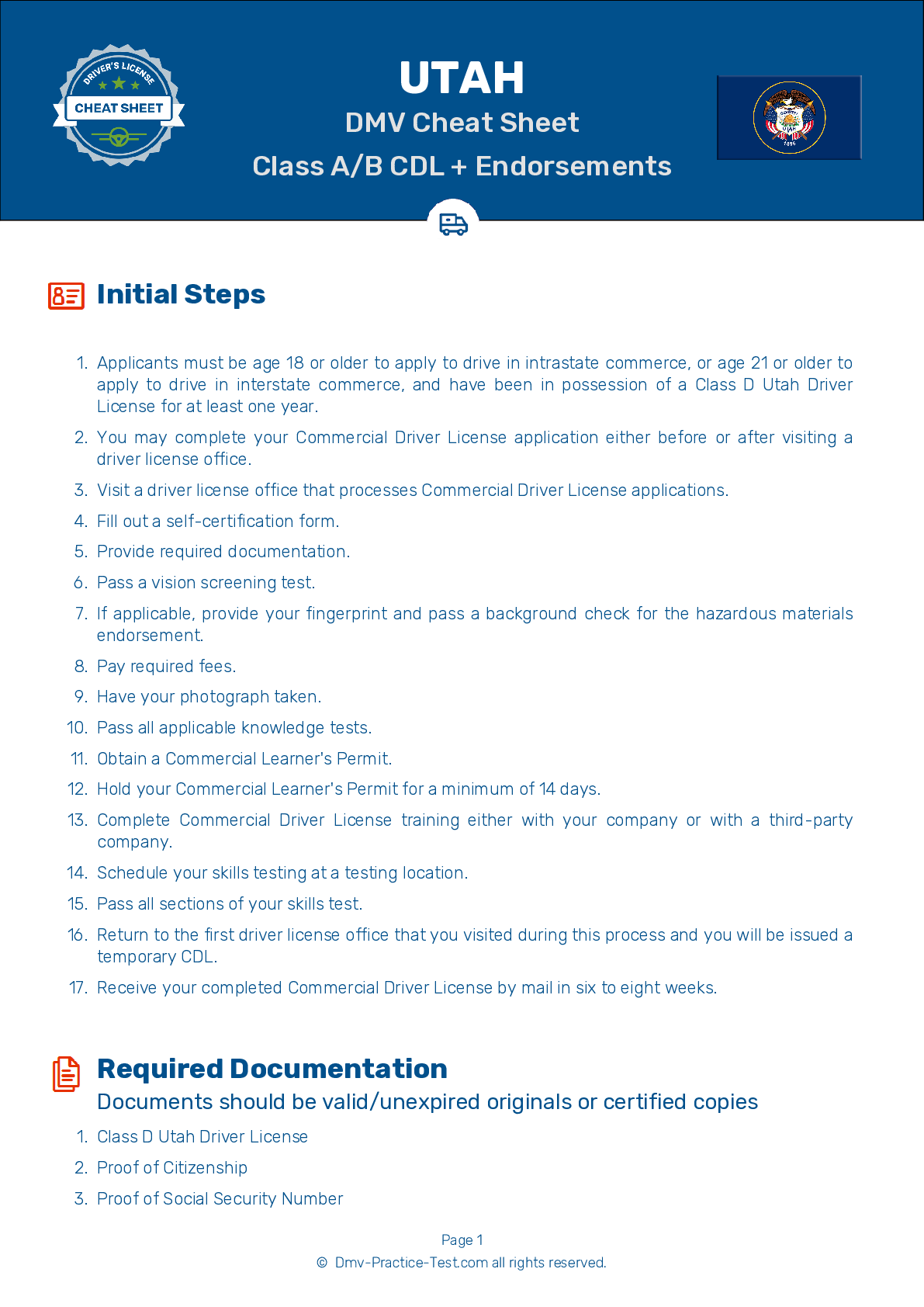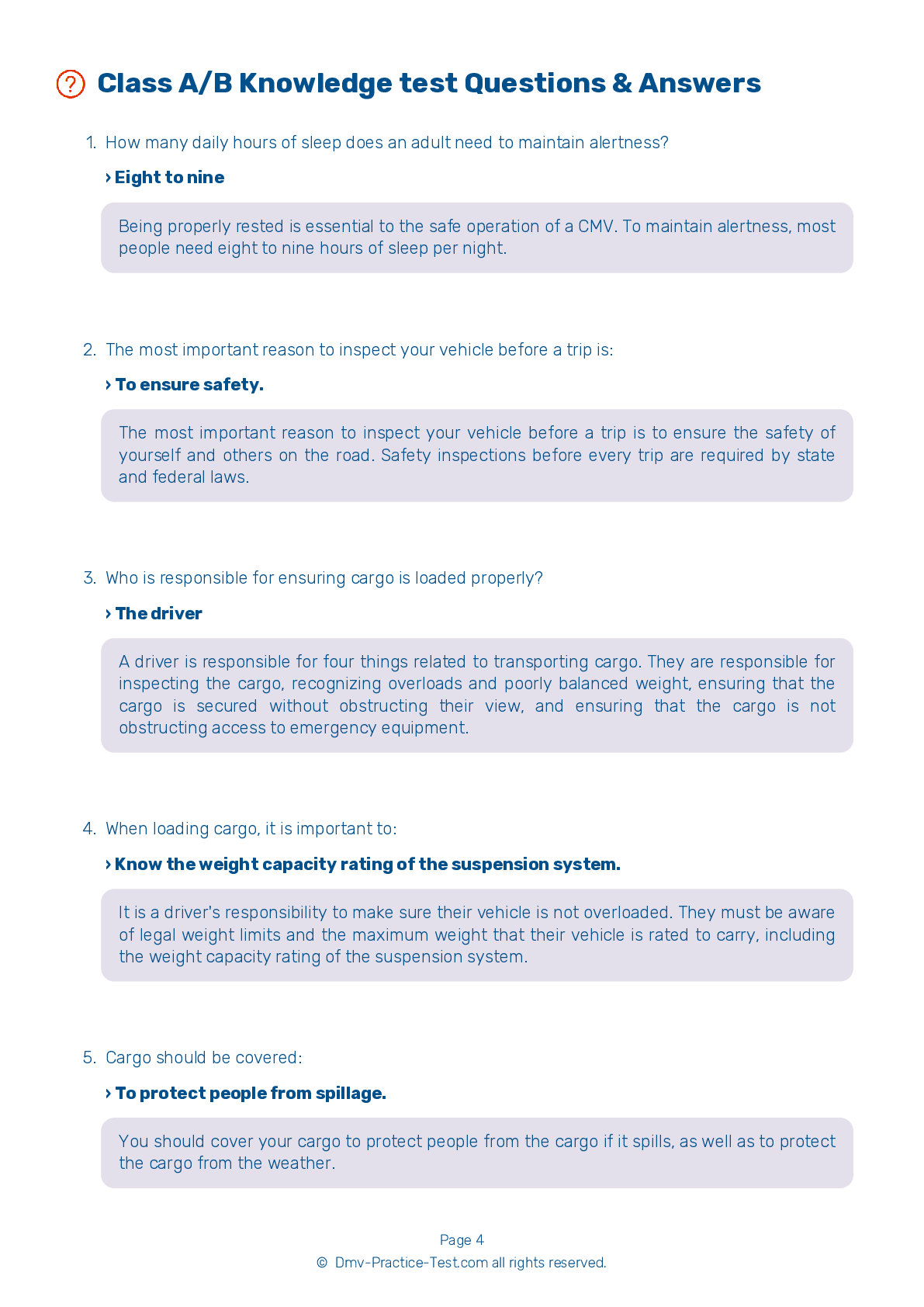Knowledge Test Class B #2
Class B Driving Test | Utah 2025 #2
Train for FREE online with our Utah class B license test. The official exam test consists of several obligatory parts, with all of them checking your knowledge of different blocks of road rules. If you need to obtain a UT CDL class B permit in 2025, practice as much as possible. Free sample tests published on our website will help you check and improve your knowledge and boost your grades. Please bear in mind that CDL class B requirements may vary from state to state.
50
40
20
1 . A CMV should:
All commercial motor vehicles are required to be equipped with the proper emergency equipment. This may include spare electrical fuses; three red reflective triangles, six fuses, or three liquid burning flares; and at least one properly charged and rated fire extinguisher.
2 . When asked to complete a conventional parallel parking maneuver, you should:
Back into the parking space without passing it first.
You may be asked to complete a conventional parallel parking maneuver into a parking space that is to the right of your vehicle. You should drive past the parking space before backing into it while bringing the rear of your vehicle as close to the rear of the space as possible. Your vehicle should be completely within the boundaries of the space.
3 . The person resonsible for a vehicle's safe operation is the shipper.
The driver is responsible for safely operating their vehicle and delivering their cargo without delay.
4 . Which of the following statements is correct?
Welded repairs are acceptable for wheels on rear axles.
Missing clamps, spacers, studs, or lugs can be a dangerous defect. Mismatched, bent, or cracked lock rings are not safe to be used. Wheels or rims with welded repairs are not safe.
5 . If there is ice on the front of your side mirror:
If your mirrors or wiper blades become icy while you are driving, you can expect the road surface to be icy as well.
6 . The minimum tread depth of all major grooves on tires that are not on the front of a CMV should be a minimum of:
3/4 of an inch.
When inspecting your tires, verify that there is at least 4/32 of an inch of tread depth in every major groove on the front tires, and tread depth of at least 2/32 of an inch on the other tires. Tires on the same vehicle should all be the same size.
7 . Three red reflective triangles should be carried within the vehicle
When inspecting a vehicle, you should ensure that it holds proper warning devices that can be used when the vehicle is parked. These warning devices may include three reflective triangles, six fuses, or three liquid burning flares.
2025 Utah | Frequently Asked Questions
To secure a CDL Bus endorsement in Utah, you must first have a Commercial Driver's License (CDL). Then, pass the Passenger Vehicle written test. After passing the test, you have to complete a training course and pass a skills test in the type of vehicle you will be driving. Lastly, pay the required fees.
To obtain a CDL Bus license in Utah, you need a valid driver's license, be at least 21 years old, and pass a vision test. You must also complete a CDL application and pass the General Knowledge test, Passenger Transport test, and School Bus Endorsement test if applicable. Lastly, you must pass a pre-trip vehicle inspection and a skills test.
Yes, specific training is necessary for a CDL Bus endorsement in Utah. After passing the Passenger Vehicle written test, you must complete a training course that includes both classroom and hands-on driving instruction. This training is designed to provide you with the skills needed to safely operate a bus and handle passengers.
CDL Bus licenses in Utah fall under three classifications: Class A, B, and C. Class A is for vehicles with a combined weight over 26,001 lbs where the towed vehicle exceeds 10,000 lbs. Class B is for single or combination vehicles where the single vehicle exceeds 26,001 lbs. Class C is for vehicles designed to transport 16 or more passengers, including the driver.
No, you cannot use your personal vehicle for the CDL Bus driving test. The vehicle you use must match the class of CDL you're applying for. So, for a bus endorsement, you'll need to test in a commercial bus. This ensures you can handle the specific vehicle type in real-world scenarios.
During the CDL Bus driving test in Utah, you will be evaluated on various skills including pre-trip vehicle inspection, basic vehicle control, and on-road driving. This includes maneuvers like stopping at designated points, backing up in a straight line or into a docking area, turning, merging and exiting traffic, and navigating intersections or railway crossings.
Yes, to obtain a CDL Bus endorsement in Utah, you must pass a Department of Transportation (DOT) physical examination. This exam ensures you're physically capable of safely operating a commercial vehicle. It covers aspects like vision, hearing, blood pressure, and checks for conditions like diabetes or heart disease that could interfere with driving safety.
No, it is illegal to transport passengers in a commercial vehicle without a valid CDL Bus endorsement in Utah. Driving a commercial vehicle, such as a bus, without the appropriate license can result in hefty fines, license suspension, or even jail time. Always ensure you have the correct endorsements for the vehicle you're operating.
Yes, the CDL Bus endorsement can be added to your existing CDL license in Utah. You'll need to pass the passenger endorsement knowledge test and a skills test in the vehicle group you wish to drive. However, you won't need to apply for a new CDL license altogether.
Yes, there are restrictions for drivers with a CDL Bus endorsement in Utah. Drivers must not have any serious traffic violations within the past two years. They are also subject to random drug and alcohol testing. Moreover, they must comply with federal regulations regarding hours of service, which limit the number of hours they can drive without rest.



